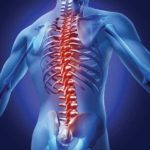Physiotherapy is the main form of treatment for sciatica pain relief. Definitely in the initial stages when you may have just started feeling the symptoms. I am always surprised when patients come to me for sciatica pain relief but have been to their doctor first and never been referred to a physio! Why? I wonder…it would have saved people so much pain in the first place. Now I do understand that there are some severe cases of sciatica pain where the person may be in constant pain and bladder and bowel can be affected. In this instance, surgery is really the only option for sciatica pain relief. However, most of the times we are able to treat sciatica with good success rate.

Why do people get sciatica pain?
Sciatic nerve is the longest nerve in the body. It originates from the spinal cord and exits the lower back travelling down the back of the leg and into the toes. As it travels, it gives out branches that supply the muscles and skin of the back of our legs. The nerve lies very close to the discs that are sandwiched between the bones of the spine. In case of a disc bulge, if it’s big enough, the bulge can push on the nerve and irritate it. There can be other causes as well like a very tight muslce deep in your buttock area or other causes like an injury( we cannot discuss all of them now). This will send sensations like electrical impulses or pins and needles or even burning & numbness , down the leg. This is exactly what is called sciatica pain. Depending upon the extent of the nerve compression the symptoms can occur. In some severe cases, the compression is so much that it can cause weakness and wasting of the leg muscles. We of course want to avoid this scenario. Hence, getting treatment for sciatica pain as soon as it happens is highly beneficial. So here are 5 important ways in which our physiotherapist can work towards sciatica pain relief for you.
Treat the root cause of sciatica pain, the lower back

9 times out of 10 we find low back pain as a common point in people suffering from sciatica pain. It’s because this is where everything may start for most people. So we first need to work on reducing the compression around that sciatic nerve. We do that by working on the spinal joints and improving the blood flow through the area. The manual therapy that we do works on reducing the swelling or inflammation that may be putting stress on the sciatic nerve causing sciatica pain. This will also help to increase the range of movment giving you more flexibility and reduce joint stiffness. One of the main techniques that distinguishes physiotherapy from other professionals is the use of manual therapy and hands on techniques. Hence, it is absolutely crucial to the treatment of sciatica pain.
Getting rid of that muscle spasm aggravating sciatica pain

The muscles of the tummy and the deeper muscles of the back form a natural brace for the lower back. So if there’s an injury, these muscles will try to protect the back from further injury and spasm. This can actually feel like a shock too! It actually can stop you in your tracks. Hence, the need to release the muscle tension in order to get more movement and giving you the confidence to move. Our physiotherapists use techniques like trigger point release and deep tissue massage to get rid of those knots in the muscles. Thereby improving flexibility.
Sciatic nerver strectching exercise
Believe it or not, the nerve can get tight too! Just like the muscles. The constant irritation on the sciatic nerve that causes the sciatica pain can actually put the nerve tissue under tension and tighten it up. This can further cause pain and get into a vicious cycle of pain-more muscle spasm- adding to further pain. By using specific nerve tension mobility exercises, we can break that cycle and reduce the nerve pain. Our physiotherapists are experienced is using the nerve tension release exercises that will help in reducing the sciatica pain. You will also walk out with a home exercise program to continue the recovery at home. But one of the ajor things in the recovery from sciatica pain or even back pain is Reformer Pilates, in my opinion. We run classes and do individual sessions to work on core strengthening. This is absolutely important to get the best results in a particular period of time. How you reduce the strain on your back at home is absolutely crucial to recovery.
The do’s and dont’s expedite your recovery from sciatica pain

What’s extremely important is the maintenance of what we achieve in our physio sessions. This is where we need your help. As physiotherapists, we can tell you exactly which movement will cause the pain. We are able to pick up a pattern that the pain follows. We will ask you specific questions to identify these patterns so we can advise you on how to modify your activities not just at work but also at home. I cannot emphasise enough how this helps in quickening your recovery. Obviously you don’t have to restrcit your activities forever. Although there may be some that you may need to make a conscious effort for initially. For examply, getting up every 30 minutes. This helps tremendously in reducing sciatica pain. Such a simple thing, yet it’s a matter of remembering. We do find much better results in people who have stuck to our advice while getting the hands on treatment for their sciatica pain.
So, if you or anyone you know may be suffering from sciatica pain, please do not delay your treatment. Call us by clicking on the button below.
